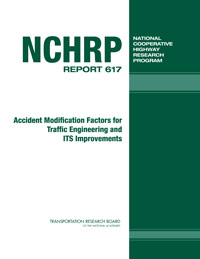

Helping engineers make safety decisions
Transportation planners and engineers use accident modification factors (AMFs), also known as crash reduction factors (CRFs), to estimate the impact certain roadway treatments, such as a traffic signal, could have in reducing crashes. AMFs are used as a tool in the decision-making process of which treatments to implement and can also help in conducting a cost/benefit analysis of alternative treatments.

Researchers at the UNC Highway Safety Research Center have done significant work in the development, analysis and modification of AMFs. In 2003, HSRC researchers joined other highway safety experts as part of National Cooperative Highway Research Project (NCHRP) 17-25 to examine AMFs and their effectiveness. HSRC recently completed that effort, which resulted in the NCHRP Report 617: Accident Modification Factors for Traffic Engineering and ITS Improvements. The report outlines 35 AMFs that are deemed to be of high or medium-high quality.
HSRC researchers also contributed to the FHWA-sponsored low-cost safety improvements pooled fund study. This ongoing study is meant to evaluate low cost treatments identified as safety strategies in the NCHRP Report 500 Guides. The overall goal of the study is to provide a CRF and benefit/cost economic analysis for each of the targeted safety strategies, and to learn and improve the process to assist in the field implementation of these safety strategies.
In Phase 1 of the study, HSRC researchers evaluated the safety impact of installing flashing beacons at stop-controlled intersections. The approach utilized the empirical Bayes method that compared the frequency, type, and severity of crashes before and after implementation of the treatment. The evaluation used data from North and South Carolina and showed that flashing beacons can be effective in reducing angle crashes at rural stop controlled intersections. In Phase 2 of the study that is currently ongoing, HSRC researchers are examining the safety effect of improving delineation on horizontal curves. Data from Connecticut and Washington are being used for this evaluation.
"Through this research being conducted at HSRC, transportation engineers now have access to additional research-based information to help make sound safety decisions," said David Harkey, HSRC director.
The development of AMFs will also contribute to future safety policies and guides, including the Highway Safety Manual (HSM). With an expected completion date of early 2010, the HSM is meant to provide practitioners with the best factual information and tools to facilitate roadway design and operational decisions based on explicit consideration of their safety consequences. Currently, there are no such widely accepted tools available for agencies responsible for managing the safety of U.S. roadways. HSRC staff recently reviewed and updated the AMFs that will be included in the first edition of the HSM.
The Center has also expanded its work in this area to include information dissemination. The Center has been awarded a contract with the Federal Highway Administration to develop an informational Web site that will contain a centralized database of AMFs. The Web site will be continuously updated to provide the most recent information available, will include a mechanism for practitioners and researchers to submit AMFs for potential inclusion on the site, and will provide resources on the application of AMFs.
The University of North Carolina Highway Safety Research Center
730 Martin Luther King Jr. Blvd, Suite 300 | Campus Box 3430 | Chapel Hill, NC 27599-3430
Phone: 919.962.2203 | Fax: 919.962.8710
http://www.hsrc.unc.edu